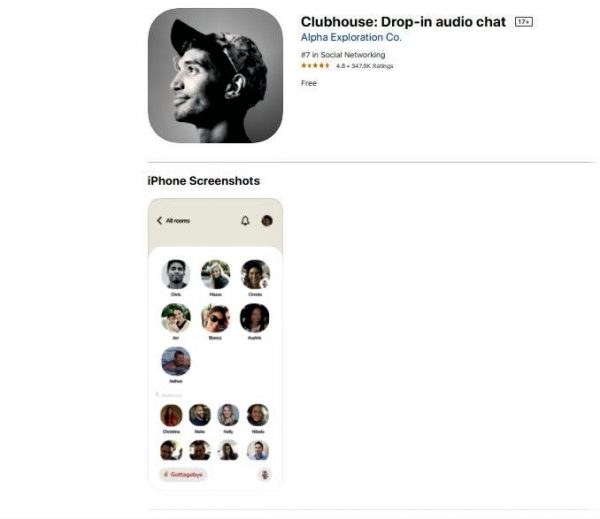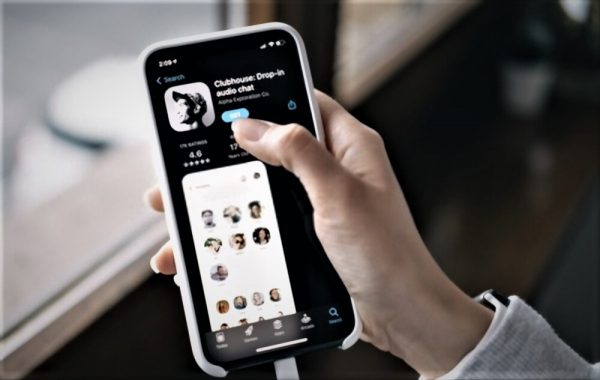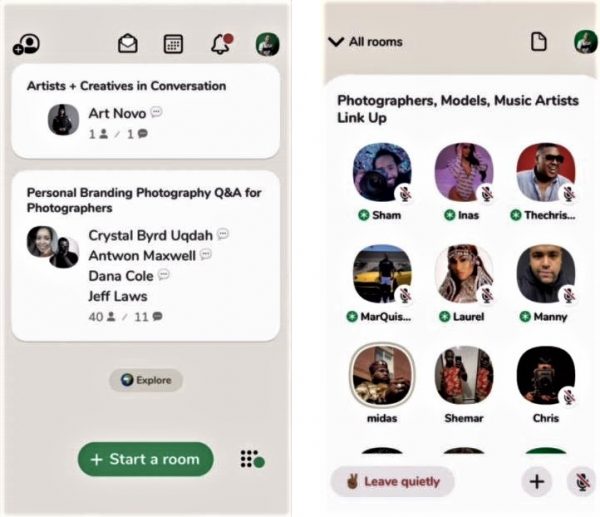Clubhouse is the latest entry in the social media world, and it stands out from the crowd for being audio-based instead of following the traditional trajectories of text and images. This app aims to encourage public discourse between people by gathering them together in individual rooms to actively discuss common topics together.
In this article, we will explore what Clubhouse is and show you how it works to change the way we think about social media. This app is also perfectly safe to use, so if you’re interested in giving it a go after reading this piece, you can rest assured.
What Is Clubhouse?

Clubhouse is an audio messenger app designed to encourage users to engage in live public conversations. This app isn’t your typical public Zoom call or Discord server though; the main difference is that you can create chat rooms revolving around different topics within the app. It could be financial management, mental health, Instagram marketing, or anything under the sun. Think of it as a public forum or an online conference, complete with hosts, speakers, moderators, and an audience.
Once you’re in Clubhouse, you can quietly drop into any conversation or chat room you want to tune into. When you drop in, you’re automatically muted so you can start by listening to the conversation first. Alternatively, if you’re a chattier person, you can host a chat room and get the ball rolling.
Another stark contrast between Clubhouse and other social media platforms is that it’s entirely exclusive. The only way to get an account and hop onto the platform is via invitation or a waitlist. This, along with the rise in Clubhouse’s popularity, has created an increased demand for Clubhouse accounts. Moreover, Clubhouse limits user invitations to four per account. With all these restrictions in place, an online marketplace has been created to let people bid for Clubhouse account invitations.
Clubhouse Chat Rooms

Clubhouse chat rooms range from spontaneous and random to professional and informative. The user base is currently populated by people from all walks of life: from industry professionals to regular folks. It’s thus unsurprising that the nature of chat rooms on the app is pretty diverse.
On one hand, you have established creatives or entrepreneurs talking about their industries and trends. On the other, there are also chat rooms for entertainment and/or gossip.
Reception & Popularity

Clubhouse was created by Rohan Seth and Paul Davison, former founders of an older app called “Talkshow.” After the previous project failed, the founders proceeded to create Clubhouse. According to them, this is their last chance at creating a social media platform that encourages conversations over text and/or image posts.
Clubhouse recently hit 3 million downloads with 2 million users after Elon Musk hosted a chat room on January 31. He maxed out the 5,000-limit for chat rooms at the time and generated immense buzz over the platform. These numbers are impressive considering Clubhouse only launched in March 2020. Thanks to these influential people endorsing the platform, Clubhouse’s value skyrocketed to $1 billion.
Unfortunately, not everyone showers the Clubhouse with praise and adoration. Many people do because of how it’s remained pretty civil so far and how peaceful the online discourse has been. However, because of the app’s nature, people also raise controversial topics that don’t sit as well with others.
For example, Taiwanese, Hong Kong, Chinese, and Uighur users recently started discussing topics regarding Chinese concentration camps in Xinjiang. This led to many people listening in and learning more about the controversy in China. When China caught wind of what was going on in Clubhouse, it promptly blocked the app. This controversy made headlines in early February 2021.
Clubhouse’s Growth & Potential

Nonetheless, even with the explosive numbers in the past year, Clubhouse remains an infant in the social media space. If you compare it to Facebook, Tik Tok, Twitter, or Snapchat, it barely makes a dent. Facebook (including Instagram and WhatsApp) has an average of 2.8 billion monthly users. Tik Tok currently has 1 billion, with Twitter and Snapchat following behind at 330 million and 249 million, respectively.
Moreover, since Clubhouse is an iOS-only app, its growth potential is rather limited at the moment. While the Clubhouse founders are considering expanding to the Android market so more people can join in on conversations, this still remains an unrealized idea as of this writing. Put into perspective, Clubhouse has a long way to go if it wants to establish a prominent online presence.
Clubhouse also has to contend with potential threats and competition. For example, Twitter has recently started developing a similar function on its platform, calling public chat rooms “Spaces.” Facebook also wants a slice of that pie and, as rumor has it, it is also developing a similar feature.
Clubhouse is still unique in that it’s an exclusive platform that’s mostly invite-only. It also gives hosts and moderators lots of control to manage their chat rooms.
How Does Clubhouse Work?
Clubhouse has a maximum capacity of 5,000 people per chat room. While that might sound overwhelming and chaotic, Clubhouse makes it work through the systems it has created. There are systems and provisions for hosts, moderators, audience members, and more. However, it can all be a little confusing when you’re new to the platform. Here’s how it works.

If you want to start a conversation or speaking event, you have to create a chat room. These rooms are similar to virtual stages and allow the hosts and moderators to speak to an audience. When the conversation begins, the host and moderators can control the flow of the discussion, choosing people from the audience to contribute to the discussion.
To do this, audience members are allowed to “raise their hands” if they want to weigh in. Moderators can then act as Clubhouse security and choose to hand over the floor to the guest they pick. There are also special audience members—those who are followed by the host or moderator. These guests are “seated” in a special area above the audience so that they’re more visible to everyone in the room.
These are the basics of rooms, hosts, moderators, and the audience. However, these standalone conversations aren’t the only way to host rooms. Clubhouse also allows for public and private “clubs” based on different categories. These could range from technology, finance, fitness, and more. Club hosts can also create upcoming events and schedules so that audiences can tune in at specific times.
The Downsides of Clubhouse
Of course, like any other social media platform, Clubhouse has its downsides. Here are some we’ve identified:
Content Moderation, Misinformation, and Harassment

One of Clubhouse’s biggest downsides is that it’s prone to content bias. This is due in large part to the power hosts and moderators have to control their chat rooms. For example, some high-profile users have the tendency to block journalists from entering their rooms. It’s especially concerning because there’s a racial and gender bias that’s at play when this happens. Female journalists are also more commonly blocked from entering certain conversations.
Furthermore, some moderators cannot handle or aren’t equipped to deal with issues that plague online communities. These include misinformation, hate speech, harassment, and more. Clubhouse itself doesn’t have any systems in place to help moderators or to prevent those problems from arising. While users can report others who violate community guidelines and harass others, Clubhouse doesn’t provide moderators with sufficient tools to deal with these problems.
Although it’s very important to hear all sides of arguments for meaningful conversations to happen, others are concerned. For example, the app allows far-right public figures to build audiences on the platform, which upsets some people. Clubhouse also allows participation from alleged assaulters like Russell Simmons and Tory Lanez.
Misinformation is also a big problem that Clubhouse has to face. While it’s important for people to verify information on their own, many people take social media information as fact.
Unproductive Conversations & Bias Towards Extroversion
Using Clubhouse doesn’t mean you have to be extroverted. Many people sign up for the app and listen to conversations just to learn a thing or two. However, because of how Clubhouse is designed, it’s more appealing to users who are naturally talkative or extroverted.
Of course, it’s not a bad thing to have a social media app built around this kind of framework. However, it can lead to unproductive conversations and idle chatter. Moreover, real-life conversations also rely on physical aspects like body language, eye contact, and more. There’s only so much you can tell about what people mean based on the things they say or their tone of voice.
No Provision for the Deaf
Another downside to Clubhouse is that it excludes deaf people. Unlike YouTube that has auto-generated captions, Clubhouse relies solely on voice and speech. That means deaf people can’t participate in conversations, especially if they can’t read lips.
The Future of Clubhouse
Clubhouse is a pretty new app that’s only one year old. It’s hence unsurprising that it still has many features that need to be polished. One problem is the erratic traffic Clubhouse generates through public figures. If you’re a regular person, the chances of you garnering an audience are slim. This means that the Clubhouse user base could vanish if public figures, celebrities, or politicians lose interest.
That’s why Clubhouse has recently set its sights on supporting creators on the platform. They’ve recently started a pilot program for creators and influencers to give more financial investment and rewards. Clubhouse has also shown some interest in creating systems like tickets, tipping, and subscriptions.
Final Word
Clubhouse is an exclusive audio-based app that seeks to provide meaningful public conversations through social media. It moves away from post-based social interactions in favor of more nuanced conversations between people. Since its launch, Clubhouse’s user base and popularity rose high, especially because public figures endorsed it.
However, as with any new social platform, there are still some things that need improvement. This includes providing better tools for content moderation, provisions for content creators, and more. While Clubhouse is fairly popular for a new social media platform, only time will tell whether its model will survive.
